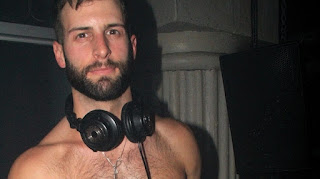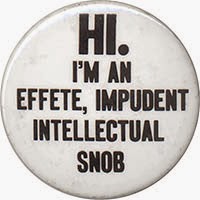More DJs: Brian Maier
Sunday, January 4, 2015
The alliterative man
The quote in my header above belongs to the 39th Vice President of the United States, Spiro Agnew. During the socially chaotic 1960s Agnew served in the administration of President Richard Nixon. He was a Republican and the touted head of what became known as the 'Silent Majority'. He was at continual logger-heads with the press and the student movement agitating against the Vietnam War. Aside from becoming quite a popular politician before resigning in 1973 for bribery, tax fraud, conspiracy and extortion, he was also a colourful speaker. He had two speech writers, and although he is remembered for his stunning alliterations, he was often not the author of some of the best zingers. William Safire and Pat Buchanan penned such masterstrokes as 'nattering nabobs of negativism', 'hopeless, hysterical hypochondriacs of history' and 'pusillanimous pussyfooters'. I heard the 'impudent snobs' line as a young man and instantly fell in love with its absolute ridiculousness. If you want to hear the man himself, please listen to him here (Spiro) as he rails against the youth movement and damns them for the perspicacity to provocate his vice-presidency :)
Thursday, January 1, 2015
A very private man: Fred Holland Day
As a man of independent means all his life, Fred Holland Day was able to choose his whims and dismiss them with equal ease. He came from a prosperous Boston merchant family, and was granted a sinecure which he was able to use toward furnishing a comfortable way of life and very particular artistic endeavours of his own.
He was a publisher, collector, and patron, but his greatest work lay in his photographic studies and his vanguard work in the Pictorialist movement. In a day when most gay men worked and lived behind the scenes, we only have his associations and his art to throw any light upon his sexual predilections.
He was a financially important patron of Aubrey Beardsley, photographed Edward Carpenter and made classical studies portraying actual, mythical and religious history. It was these studies, usually with the help of a coterie of young boys, that really reveal his sexual leanings. Their style followed the European Decadent movement. His work, though, was at the forefront of the Pictorialist movement in the United States. He was a major voice in the new world for the recognition of photography as a pure art and not just a sterile record of reality. In its early incarnations he was the face of the Pictorialist movement and its American offspring, the Photo-Secessionists. He was later replaced by the presence of Alfred Stieglitz in the artistic consciousness of these movements. In 1902 he broke with Stieglitz after a serious argument, distancing himself from its power centre. He had the means and the emotional predisposition to 'go it alone' if need be. If difficulties ever arose to block his interests he could act as he pleased. In this case he broke with the movement.
There are a number of reasons why he has been virtually forgotten as a revolutionary photographer. A fire in 1904 destroyed the larger part of his plates and prints, of which there were thousands. Some few hundred survived the fire and have been spread out between a number of museums. He often only made one print of his work, limiting how much his photos could be seen by the public. He also flatly gave up photography during the period of the Russian Revolution. He had adopted the platinum process exclusively and declared it, for his own artistic ends, as the height of photographic expression. When the revolution cut off the supply of platinum, he abandoned photography for good. As well, as the century progressed, the Pictorialist movement was eclipsed by Modernism and his work went out of fashion.
Aside from his boys (of which the pubescent Kahlil Gibran was a model), he also featured himself, and even his black servant, in his work. There is a frank homoerotic element in these studies of boys with lyres, in tunics (or not), or in sailor suits. There is also a kind of modern permissiveness in the images, as old as they are, and as much as they may also disturb some people. Regardless, they still stir the aesthete in all of us.
Having been born at the chaotic end of the American Civil War, he lived on into the first years of the Great Depression, dying in 1933 at the age of 69. By the year of his death WPA photographers were roaming the American plains and taking some of the most iconic photography that the world has since seen. The hard-bitten imagery of strife in the face of economic hardship was a cauldron for the forging of a new artistic temperament - and a whole new generation of photographers, who would make a lasting impression on the art of photography to the present day. Photography as an art form matured into one of the three legs of modern mass media by the end of the Second World War.
Was Day opportunistic or predatory? That is a hard question to answer, but there are clues to be found. Any question of racism can be dismissed. He grew up in a now vanished class of enlightened money. His mother was a prominent abolitionist. We can say, considering how private Day was, that he was somewhat opportunistic, but he merely used the people around him for his artistic ends. Being an avant-garde artist in a staunchly conservative Boston, he took what help he could muster. For a photo series on the crucifixion (he played Christ), local neighbours in Norwood Massachusetts helped him with the outdoor staging. Was he a lover of boys? A paedophile, or even a pederast? That is a much harder question to answer. In any event, all the players in these now forgotten mythic renditions are dead, all having passed away along with this quite arch and interesting form of photography.
Detail of the series on Saint Sebastian
Day in the costume of a medieval nobleman
Day with his manservant
The Lebanese poet Kahlil Gibran as a young boy
Day photographed with Maynard White
Wednesday, December 31, 2014
Subscribe to:
Comments (Atom)
.jpg)
.jpg)
.jpg)
.jpg)







.jpg)
.jpg)
.jpg)
.jpg)
.jpg)
.jpg)
.jpg)










.jpg)
.jpg)



.jpg)
.jpg)

























